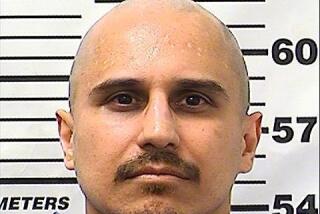Serial killer in Anchorage case ‘enjoyed telling us details’
SEATTLE — As they talked with him in a conference room at the federal courthouse in Anchorage, agents already were confident they had Samantha Koenig’s abductor.
They had surveillance footage of Israel Keyes’ truck parked outside of the lonely coffee stand where Koenig was working when she was kidnapped one frozen night in Anchorage. They had the ATM withdrawals the 34-year-old construction worker had made with her bank card. They had a ski mask found in the trunk of his vehicle. It wasn’t long before he confessed.
It was the way Keyes confessed to the killing that day in March that turned the agents’ confidence to alarm: The adrenaline was almost visible as he described how overwhelmingly powerful he felt as he pointed a gun at Koenig’s ribs.
“His demeanor, the level of detail, the lack of remorse, the enjoyment he was getting out of telling certain details,” recalled Kevin Feldis, chief of the criminal division for the U.S. attorney’s office in Alaska.
Feldis felt a growing suspicion: “This was not the first time he killed somebody.”
Over the last few months, Feldis and a team of detectives in Anchorage have been sharing jokes, bagels and coffee with the often-talkative but cagey suspect who had promised to tell them everything about his crimes.
By November, Keyes had admitted to eight slayings and hinted there were more, laying out a trail of killings, arson, robbery and sexual assault that spanned the width of the country. His death in a jailhouse suicide last week left law enforcement authorities scrambling to identify all eight victims and figure out how many others may have fallen prey to a man they now believe was a meticulous and prolific serial killer.
The FBI has banked Keyes’ DNA and asked police and the public across the country to come forward with unsolved deaths, disappearances and possible sightings in an attempt to learn who his other victims may have been. A photo surfaced this week of someone who could have been Keyes robbing a bank in New York. Agents are pushing especially hard here in Washington state, where Keyes lived before moving to Alaska, and where, he told authorities, he had killed four people between 2001 and 2006.
“The investigators are going over everything. There might be more they can extract from what he already told them that they didn’t think about before — maybe if they put it in a different context, it could provide something important,” said Ayn Dietrich, FBI spokeswoman in Seattle.
Keyes appears to have spent many of his teenage years in the wooded hills of eastern Washington, north of Colville. He’s the second-youngest of 10 siblings, many with Biblical names like Charity and Hosanna, who were instructed in homesteading skills such as carpentry and making goat milk soap. The family moved to the outskirts of an Amish community in Maine when Keyes’ father grew concerned that their upbringing was not rigorous enough.
“Around the age of 11 and 12, my heart turned in rebellion toward my parents: My two older sisters and I were in a kind of revolt against them. We had friends they did not like, we secretly listened to music they forbade, and we got away with as much as we could,” Keyes’ sister, Autumnrose, wrote in a recent testimonial about her faith on her church’s website. “I’ve thanked God many times for my earthly father, who was a strict man. When my sins came to light by God’s mercy, he pulled me away from my circumstances and moved the family to an Amish community.”
Keyes joined the Army in 1998 and was posted at the former Ft. Lewis base near Tacoma, Wash., at the time of his discharge in 2001. From there, he got a job doing maintenance and light construction in the remote Native American tribal community of Neah Bay, Wash. He had a daughter with a local woman and sought to win partial custody after they broke up.
“He seemed totally normal. He was quiet; he was more reserved, I guess, but you never would have picked him out for doing something like this.... In no sense of the word was he in any way weird,” said David Kanters, who worked with one of Keyes’ girlfriends.
“He would tell me about his days in the armed services and the parties they had. He would lovingly talk about his daughter, or tell me when he’d been up late because she was sick,” said Jim Thompson, a volunteer who sometimes helped Keyes clean up community areas around Neah Bay.
About 2007, Keyes followed a girlfriend to Anchorage, where he started a construction company under his own name.
He was “reliable, unfailingly polite and responsive — you called, he called you back,” said Paul Adelman, who had hired Keyes to do projects. “I completely trusted him with his work. If he gave me a bill, I always paid, no questions asked.”
In March, shortly after he had killed Koenig, Keyes took his daughter to visit his mother and four sisters in Texas, where after Keyes’ father died they had become members of the Church of Wells, which preaches strict spiritual separation from mainstream churches.
One of his sisters was marrying another member of the church. Pastor Jake Gardner later told a Texas television station that Keyes professed to be an atheist, and argued with church elders who tried to bring him into the faith.
“Even at the wedding the Lord pled with him and pled with him and in the midst of it all he wept and broke down weeping, bawling, even wailing, but he would not repent,” Gardner said. “He said … to one of the pastors in the church, ‘Not everybody has your morals,’ with an undertone of hate and murder in his heart.”
Keyes’ frequent trips across the country were opportunities to stash weapons, ammunition and other material used in his fatal assaults, FBI agents said.
Keyes was perhaps 18 years old when he committed his first sexual crime, which he described as a violent assault on a teenage girl he encountered on the Deschutes River in Oregon. The attack was apparently never reported. “He intended to kill her, but decided to let her go,” said Agent Jolene Goeden, who spent much of the summer debriefing Keyes whenever he was in the mood to talk.
Agents heard horrific details of Keyes’ killing of Bill and Lorraine Currier in June 2011. Keyes cut the phone line to their house in Essex, Vt., broke in through the garage and tied them up in their bedroom. He took the couple to an old barn nearby, where he shot Bill Currier, then raped and strangled his wife.
“By all accounts they were friendly, peaceful, good people who encountered a force of pure evil acting at random,” said Tristram Coffin, U.S. attorney for Vermont.
Keyes told detectives he would wander around isolated places like trail heads and boat docks, looking for victims.
“Back when I was smart, I would let them come to me … kind of go to a remote area that’s not anywhere near where you live, but that other people go to as well,” he said, in one of the interview snippets federal authorities have released. “Not as much to choose from, in a manner of speaking, but there’s also no witness, really. There’s no one else around.”
He told the agents about robbing a bank in Tupper Lake, N.Y., in April 2009, and another one in Azle, Texas, in February. Only last week, they said, he provided a few details about two of the four killings he reported committing in Washington state.
“I think he was conflicted on telling us and not telling us. When he was telling us details, he enjoyed telling us details. It was chilling to listen to him, to watch him,” said Anchorage Police Officer Jeff Bell, who worked with the FBI on the case.
Koenig was abducted at gunpoint Feb. 1 from the coffee stand where she worked, and was taken to a shed outside Keyes’ home, where he raped and strangled her. Keyes took a photo of Koenig’s body to make it appear she was still alive and sent it with a ransom demand. Her family raised the money through community donations, and police kept track as Keyes withdrew the cash at ATMs across Arizona, New Mexico and Texas, where he was arrested March 13.
Keyes used Google Earth to show detectives where he’d deposited Koenig’s body under the ice of a lake northwest of Anchorage, allowing them to find her. Parts of the gun used to kill the Curriers were recovered from a reservoir at Parishville, N.Y., and a cache containing a shovel and two large bottles of Drano was discovered north of Anchorage.
Keyes was keenly interested in how his crimes played out in public, searching the Web for stories about his Vermont victims before his arrest. Detectives played on that in an effort to keep him talking, giving him copies of articles about his case, and letting him know when a new development was imminent.
Feldis, of the U.S. attorney’s office in Alaska, said it was clear that Keyes was motivated to talk not by any wish to help victims’ families, but rather to control his own narrative. He told detectives they were wasting their time if they tried to pursue leads without his help.
“There is no one who knows me — or who has ever known me — who knows anything about me, really,” Keyes told his questioners in one of the video excerpts released. “They’re going to tell you something that does not line up with anything I tell you, because I’m two different people, basically. And the only person who knows about what I’m telling you — the kind of things I’m telling you — is me.”
Murphy reported from Seattle; Pearce from Los Angeles.
More to Read
Sign up for Essential California
The most important California stories and recommendations in your inbox every morning.
You may occasionally receive promotional content from the Los Angeles Times.











